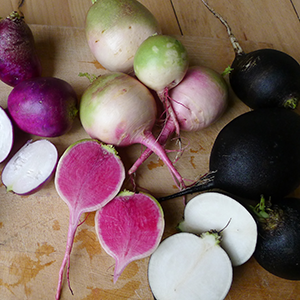
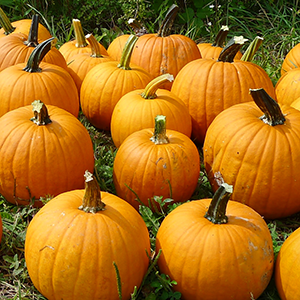
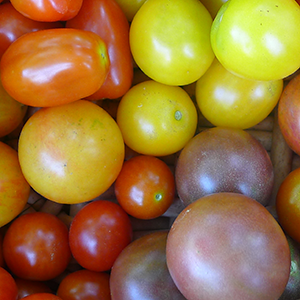
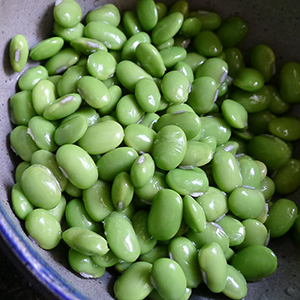
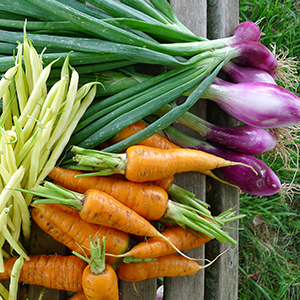
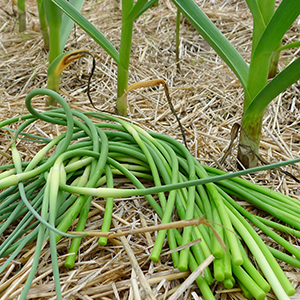



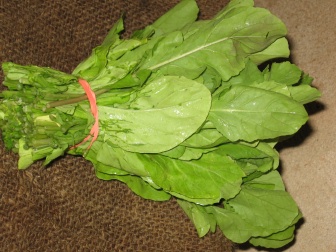
.jpg)
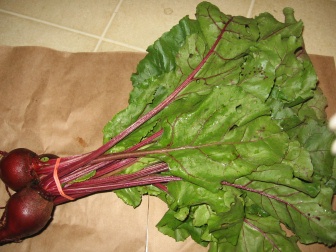 Both beets and Swiss chard are different varieties within the same plant family and their edible leaves share a resemblance in both taste and texture. Attached to the beet's green leaves is a round or oblong root, the part conjured up in most people's minds by the word "beet." Although typically a beautiful reddish-purple hue, beets also come in varieties that feature white or golden roots. No matter what their color, however, beet roots aren't as hardy as they look; the smallest bruise or puncture will cause red beets' red-purple pigments, which contain beneficial flavonoids called anthycyanins, to bleed, especially during cooking. They are incredibly rich in nutrients, concentrated in vitamins and minerals as well as carotenoids such as beta-carotene and lutein/zeaxanthin.
Both beets and Swiss chard are different varieties within the same plant family and their edible leaves share a resemblance in both taste and texture. Attached to the beet's green leaves is a round or oblong root, the part conjured up in most people's minds by the word "beet." Although typically a beautiful reddish-purple hue, beets also come in varieties that feature white or golden roots. No matter what their color, however, beet roots aren't as hardy as they look; the smallest bruise or puncture will cause red beets' red-purple pigments, which contain beneficial flavonoids called anthycyanins, to bleed, especially during cooking. They are incredibly rich in nutrients, concentrated in vitamins and minerals as well as carotenoids such as beta-carotene and lutein/zeaxanthin.
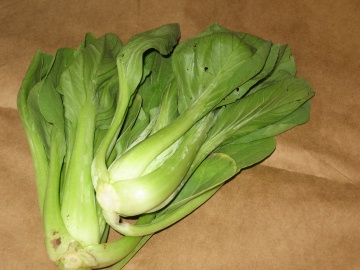 Bok Choy is an Asian member of the Cabbage family that has a mild flavor. It consists of long, thick, white stalks, topped by blue-green spinach like leaves. Bok Choy is a very good source of calciium and vitamins A and C.
Bok Choy is an Asian member of the Cabbage family that has a mild flavor. It consists of long, thick, white stalks, topped by blue-green spinach like leaves. Bok Choy is a very good source of calciium and vitamins A and C.
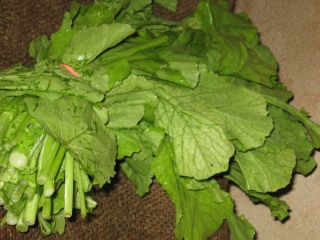 Broccoli Rabe (pronounced Broccoli Rob) is also referred to as rabe or rapini. The vegetable has a slightly bitter taste. The Broccoli Rabe flower looks similar to the broccoli florets. Despite the name this plant is not a type of broccoli but it is in the same brassica or mustard family. One of the many health benefits of this vegetable is that it is rich in many phytochemicals and minerals. Unlike broccoli, if broccoli raab has a bit of yellow showing in the flowers, it is still fine to eat.
Broccoli Rabe (pronounced Broccoli Rob) is also referred to as rabe or rapini. The vegetable has a slightly bitter taste. The Broccoli Rabe flower looks similar to the broccoli florets. Despite the name this plant is not a type of broccoli but it is in the same brassica or mustard family. One of the many health benefits of this vegetable is that it is rich in many phytochemicals and minerals. Unlike broccoli, if broccoli raab has a bit of yellow showing in the flowers, it is still fine to eat.
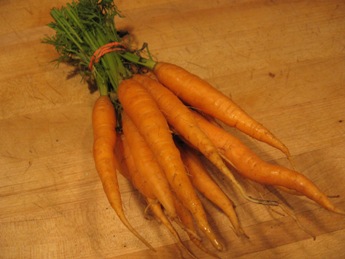 The favorite food of Bugs Bunny hardly needs a description for they are well known and loved by even the youngest children in many countries. Carrots benefits are legendary. Bet your mother told you that eating carrots would keep your eyesight bright. While we usually associate carrots with the color orange, in fact, carrots grow in a host of other colors including white, yellow, red, or purple, the latter being the color of the original variety. The carrot is a plant with a thick, fleshy, deeply colored root, which grows underground, and feathery green leaves that emerge above ground. It is known scientifically as Daucus carota, a name that can be traced back to ancient Roman writings of the 3rd century. Carrots belong to the Umbelliferae family, named after the umbrella like flower clusters that plants in this family produce. As such, carrots are related to parsnips, fennel caraway, cumin and dill. There are over 100 different varieties that vary in size and color. Carrots can be as small as two inches or as long as three feet, ranging in diameter from one-half of an inch to over two inches. Carrot roots have a crunchy texture and a sweet and minty aromatic taste, while the greens are fresh tasting and slightly bitter. Carrots are an excellent source of antioxidant compounds, and the richest vegetable source of the pro-vitamin A carotenes. Carrots' antioxidant compounds help protect against cardiovascular disease and cancer and also promote good vision, especially night vision.
The favorite food of Bugs Bunny hardly needs a description for they are well known and loved by even the youngest children in many countries. Carrots benefits are legendary. Bet your mother told you that eating carrots would keep your eyesight bright. While we usually associate carrots with the color orange, in fact, carrots grow in a host of other colors including white, yellow, red, or purple, the latter being the color of the original variety. The carrot is a plant with a thick, fleshy, deeply colored root, which grows underground, and feathery green leaves that emerge above ground. It is known scientifically as Daucus carota, a name that can be traced back to ancient Roman writings of the 3rd century. Carrots belong to the Umbelliferae family, named after the umbrella like flower clusters that plants in this family produce. As such, carrots are related to parsnips, fennel caraway, cumin and dill. There are over 100 different varieties that vary in size and color. Carrots can be as small as two inches or as long as three feet, ranging in diameter from one-half of an inch to over two inches. Carrot roots have a crunchy texture and a sweet and minty aromatic taste, while the greens are fresh tasting and slightly bitter. Carrots are an excellent source of antioxidant compounds, and the richest vegetable source of the pro-vitamin A carotenes. Carrots' antioxidant compounds help protect against cardiovascular disease and cancer and also promote good vision, especially night vision.
Celeriac is loaded with Vitamin C, potassium, and phosphorous.The flesh is crispy when raw, silky smooth when cooked.
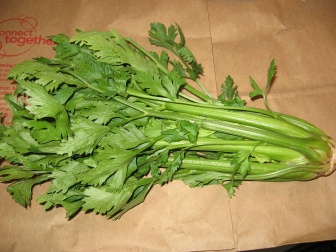 Celery is as well-known as potatoes, onions and carrots. Its crunchy texture and distinctive flavor makes it a popular addition to salads and many cooked dishes. Although it is available throughout the year, you will enjoy the best taste and quality of celery during the summer months when it is in season and locally grown varieties can be easily found in the markets. It is a biennial vegetable plant that belongs to the Umbelliferae family whose other members include carrots, fennel, parsley and dill. While most people associate celery with its prized stalks, the leaves, roots and seeds can also be used as a food and seasoning as well as a natural medicinal remedy.
Celery is as well-known as potatoes, onions and carrots. Its crunchy texture and distinctive flavor makes it a popular addition to salads and many cooked dishes. Although it is available throughout the year, you will enjoy the best taste and quality of celery during the summer months when it is in season and locally grown varieties can be easily found in the markets. It is a biennial vegetable plant that belongs to the Umbelliferae family whose other members include carrots, fennel, parsley and dill. While most people associate celery with its prized stalks, the leaves, roots and seeds can also be used as a food and seasoning as well as a natural medicinal remedy.
Celery is very high in Vitamins K and C, and contrary to some people's belief, it is not high in sodium.
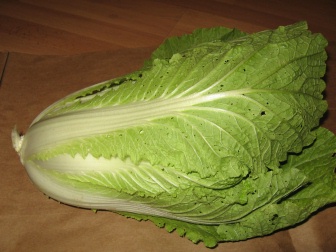 Chinese cabbage is also called Napa cabbage. It is a mild and slightly crunchy green that is most often eaten raw in salads or coleslaw. Because it is in the same family as broccoli, it shares many of the same health benefits and phytochemicals. In order to preserve the vitamins, do not cut the cabbage until you are ready to use it.
Chinese cabbage is also called Napa cabbage. It is a mild and slightly crunchy green that is most often eaten raw in salads or coleslaw. Because it is in the same family as broccoli, it shares many of the same health benefits and phytochemicals. In order to preserve the vitamins, do not cut the cabbage until you are ready to use it.
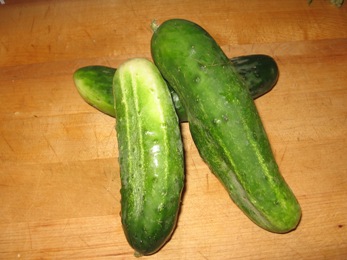 Cucumbers, scientifically known as Cucumis sativus, are grown to either be eaten fresh or to be pickled. Those that are to be eaten fresh are commonly called slicing cucumbers. They are cylindrical in shape and commonly range in length from about six to nine inches, although they can smaller or much larger. Their skin, which ranges in color from green to white, may either be smoothed or ridged depending upon the variety. Inside a cucumber is a very pale green flesh that is dense yet aqueous and crunchy at the same time, as well as numerous edible fleshy seeds. Cucumbers that are cultivated to make pickles are oftentimes much smaller than slicing cucumbers. Gherkins are one variety of cucumbers cultivated for this purpose. The flesh of cucumbers is primarily composed of water but also contains vitamin C and caffeic acid, both of which help soothe skin irritations and reduce swelling. Cucumbers'hard skin is rich in fiber and contains a variety of beneficial minerals including silica, potassium and magnesium.
Cucumbers, scientifically known as Cucumis sativus, are grown to either be eaten fresh or to be pickled. Those that are to be eaten fresh are commonly called slicing cucumbers. They are cylindrical in shape and commonly range in length from about six to nine inches, although they can smaller or much larger. Their skin, which ranges in color from green to white, may either be smoothed or ridged depending upon the variety. Inside a cucumber is a very pale green flesh that is dense yet aqueous and crunchy at the same time, as well as numerous edible fleshy seeds. Cucumbers that are cultivated to make pickles are oftentimes much smaller than slicing cucumbers. Gherkins are one variety of cucumbers cultivated for this purpose. The flesh of cucumbers is primarily composed of water but also contains vitamin C and caffeic acid, both of which help soothe skin irritations and reduce swelling. Cucumbers'hard skin is rich in fiber and contains a variety of beneficial minerals including silica, potassium and magnesium.
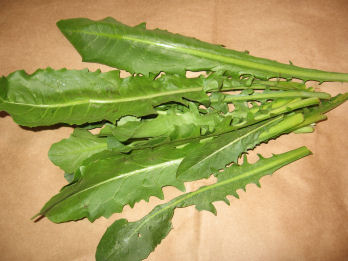 Dandelion greens are the leaves of the common dandelion plant, which many people think of as a weed. In fact, dandelions are edible and highly nutritious. The use of dandelion greens as a food dates back for centuries. In France, the plants came to be known as dent de lion, or “lion's teeth” in a reference to the long, jagged leaves and the sunny flowers which do rather resemble the manes of lions. With some adjustment to the name, the plant made its way into the English language, as well as the English diet. Dandelion greens are rich in iron, calcium and vitamins B, C, and E, among many others.
Dandelion greens are the leaves of the common dandelion plant, which many people think of as a weed. In fact, dandelions are edible and highly nutritious. The use of dandelion greens as a food dates back for centuries. In France, the plants came to be known as dent de lion, or “lion's teeth” in a reference to the long, jagged leaves and the sunny flowers which do rather resemble the manes of lions. With some adjustment to the name, the plant made its way into the English language, as well as the English diet. Dandelion greens are rich in iron, calcium and vitamins B, C, and E, among many others.
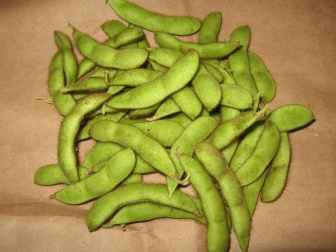 Edamame is a green vegetable more commonly known as a soybean, harvested at the peak of ripening right before it reaches the "hardening" time. The word Edamame means "Beans on Branches," and it grows in clusters on bushy branches. To retain the freshness and its natural flavor, it is parboiled and quick-frozen. In East Asia, the soybean has been used for over two thousand years as a major source of protein.There are plenty of articles available detailing the benefits of consuming soybeans. They are an excellent source of protein, as well as a good source of calcium, phosphorous, and vitamins A and C.
Edamame is a green vegetable more commonly known as a soybean, harvested at the peak of ripening right before it reaches the "hardening" time. The word Edamame means "Beans on Branches," and it grows in clusters on bushy branches. To retain the freshness and its natural flavor, it is parboiled and quick-frozen. In East Asia, the soybean has been used for over two thousand years as a major source of protein.There are plenty of articles available detailing the benefits of consuming soybeans. They are an excellent source of protein, as well as a good source of calcium, phosphorous, and vitamins A and C.
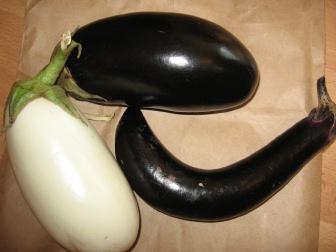 Eggplants belong to the plant family commonly known as nightshades, and are related to the tomato, bell pepper and potato. Eggplants are best known as large globe shaped and deep purple in color. But, they are also available in long, thin, forms, which are also known as Asian eggplants, and other colors include lavender, jade green, orange, and yellow-white, as well as in sizes and shapes that range from that of a small tomato to a large zucchini. While the different varieties vary slightly in taste and texture, the eggplant can be described as having a pleasantly bitter taste and spongy texture. In many recipes, eggplant fulfills the role of being a complementary ingredient that balances the surrounding flavors of the other more pronounced ingredients. Many people say that eggplants should be salted and left to stand for 15-30 minutes prior to cooking to remove bitterness. Today, breeding has made eggplants more mild. Also, Chef Mario Batali (known for his Italian cuisine), states in one of his cookbooks "salting eggplant causes a collapse of the cell walls and reduces its ability to absorb both fat and other liquids. I do not salt eggplant unless I am preserving it by canning or pickling". Eggplant is a very good source of dietary fiber, potassium, manganese, copper and thiamin (vitamin B1). It is also a good source of vitamin B6, folate, magnesium and niacin.
Eggplants belong to the plant family commonly known as nightshades, and are related to the tomato, bell pepper and potato. Eggplants are best known as large globe shaped and deep purple in color. But, they are also available in long, thin, forms, which are also known as Asian eggplants, and other colors include lavender, jade green, orange, and yellow-white, as well as in sizes and shapes that range from that of a small tomato to a large zucchini. While the different varieties vary slightly in taste and texture, the eggplant can be described as having a pleasantly bitter taste and spongy texture. In many recipes, eggplant fulfills the role of being a complementary ingredient that balances the surrounding flavors of the other more pronounced ingredients. Many people say that eggplants should be salted and left to stand for 15-30 minutes prior to cooking to remove bitterness. Today, breeding has made eggplants more mild. Also, Chef Mario Batali (known for his Italian cuisine), states in one of his cookbooks "salting eggplant causes a collapse of the cell walls and reduces its ability to absorb both fat and other liquids. I do not salt eggplant unless I am preserving it by canning or pickling". Eggplant is a very good source of dietary fiber, potassium, manganese, copper and thiamin (vitamin B1). It is also a good source of vitamin B6, folate, magnesium and niacin.
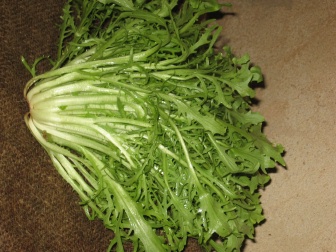 Endive has two forms, narrow-leaved endive called curly endive and the broad-leaved endive which is often called escarole. The outside leaves of an endive head are green and bitter. The inner leaves of the endive head are light green to creamy-white and milder flavored. Endive is rich in many vitamins and minerals, especially in folate and vitamin A and K, and is high in fiber.
Endive has two forms, narrow-leaved endive called curly endive and the broad-leaved endive which is often called escarole. The outside leaves of an endive head are green and bitter. The inner leaves of the endive head are light green to creamy-white and milder flavored. Endive is rich in many vitamins and minerals, especially in folate and vitamin A and K, and is high in fiber.
Fennel is a versatile vegetable that plays an important role in the food culture of many European nations, especially in France and Italy. Its esteemed reputation dates back to the earliest times and is reflected in its mythological traditions. Greek myths state that fennel was not only closely associated with Dionysus, the Greek god of food and wine, but that a fennel stalk carried the coal that passed down knowledge from the gods to men.
Fennel is composed of a white or pale green bulb from which closely superimposed stalks are arranged. The stalks are topped with feathery green leaves near which flowers grow and produce fennel seeds. The bulb, stalk, leaves, and seeds are all edible. Fennel belongs to the Umbellifereae family and is therefore closely related to parsley, carrots, dill, and coriander.
Fennel's aromatic taste is unique, strikingly reminiscent of licorice and anise, so much so that fennel is often mistakenly referred to as anise in the marketplace. Fennel's texture is similar to that of celery, having a crunchy and striated texture.
Fennel is a good source of Vitamin C, potassium, and dietary fiber.
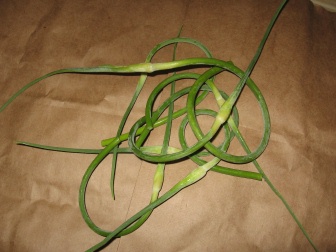 Scapes are the flower stalks found on all members of the Allium family (onions, leeks, chives, and garlic). Garlic scapes are a delicacy in some Asian cuisines and are available occasionally at farmer's markets as well as gourmet restaurants. If the scape is left on the plant it will harden and transform from green to the familiar opaque white/beige color of garlic peel. Keeping the shoot attached will curtail growth of the bulb. So, in an effort to allow the garlic to keep growing, the farmer picks the scape off the plant and we benefit with an edible delectable that cooks are just beginning to discover.
Scapes are the flower stalks found on all members of the Allium family (onions, leeks, chives, and garlic). Garlic scapes are a delicacy in some Asian cuisines and are available occasionally at farmer's markets as well as gourmet restaurants. If the scape is left on the plant it will harden and transform from green to the familiar opaque white/beige color of garlic peel. Keeping the shoot attached will curtail growth of the bulb. So, in an effort to allow the garlic to keep growing, the farmer picks the scape off the plant and we benefit with an edible delectable that cooks are just beginning to discover.
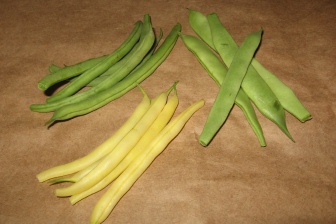 While green beans are typically referred to as string beans, many varieties no longer actually feature the fibrous 'string' that runs down the length of the earlier varieties. Green beans are also commonly known as snap beans. Haricots verts are French green beans that are very thin and very tender. Green beans are in the same family as shell beans, such as pinto beans, black beans and kidney beans. Yet unlike their cousins, green beans' entire bean, pod and seed, can be eaten. They are usually deep emerald green in color but are alsowonderful in their yellow, flat orRoma, and mottled varieties. They contain tiny seeds within their thin pods. Green beans are an excellent source of vitamin C, vitamin K and manganese. Plus green beans are very good source of vitamin A (notably through their concentration of carotenoids including beta-carotene), dietary fiber, potassium, folate, and iron. And, green beans are a good source of magnesium, thiamin, riboflavin, copper, calcium, phosphorus, protein, omega-3 fatty acids and niacin.
While green beans are typically referred to as string beans, many varieties no longer actually feature the fibrous 'string' that runs down the length of the earlier varieties. Green beans are also commonly known as snap beans. Haricots verts are French green beans that are very thin and very tender. Green beans are in the same family as shell beans, such as pinto beans, black beans and kidney beans. Yet unlike their cousins, green beans' entire bean, pod and seed, can be eaten. They are usually deep emerald green in color but are alsowonderful in their yellow, flat orRoma, and mottled varieties. They contain tiny seeds within their thin pods. Green beans are an excellent source of vitamin C, vitamin K and manganese. Plus green beans are very good source of vitamin A (notably through their concentration of carotenoids including beta-carotene), dietary fiber, potassium, folate, and iron. And, green beans are a good source of magnesium, thiamin, riboflavin, copper, calcium, phosphorus, protein, omega-3 fatty acids and niacin.
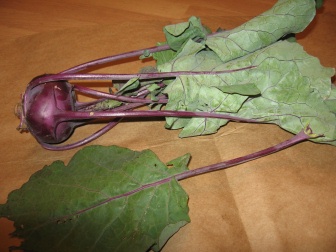 The kohlrabi is a member of the cabbage (crucifer or mustard) family. The part we eat is the enlarged stem from which the leaves develop. Kohlrabi may be white, green or purple in color. The taste and texture of kohlrabi are similar to those of a broccoli stem or cabbage heart, but milder and sweeter, with a higher ratio of flesh to skin. Kohlrabi is a great source of vitamin C and potassium.
The kohlrabi is a member of the cabbage (crucifer or mustard) family. The part we eat is the enlarged stem from which the leaves develop. Kohlrabi may be white, green or purple in color. The taste and texture of kohlrabi are similar to those of a broccoli stem or cabbage heart, but milder and sweeter, with a higher ratio of flesh to skin. Kohlrabi is a great source of vitamin C and potassium.
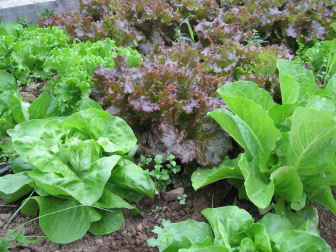 Lettuce is familiar to most people, but what you may not know is that it is in the same family as the daisy! Due to the fact that about 95% of lettuce in the US is grown in California and Arizona, many people have not had the opportunity to enjoy the taste of truly fresh lettuces, nor the variety that you will receive as part of your share. Unlike iceberg lettuce, which contains almost no nutrients, other types, such as romaines and even butterheads, contain 50-75% of vitamins C, A and K in a 2 cup serving.
Lettuce is familiar to most people, but what you may not know is that it is in the same family as the daisy! Due to the fact that about 95% of lettuce in the US is grown in California and Arizona, many people have not had the opportunity to enjoy the taste of truly fresh lettuces, nor the variety that you will receive as part of your share. Unlike iceberg lettuce, which contains almost no nutrients, other types, such as romaines and even butterheads, contain 50-75% of vitamins C, A and K in a 2 cup serving.
- Romaine: Also known as Cos, this variety of head forming lettuce has deep green, long leaves with a crisp texture and deep taste.
- Crisphead: With green leaves on the outside and whitish ones on the inside, this variety of head lettuce has a crisp texture and a watery, mild taste. The best known variety of crisphead lettuce is iceberg but you are likely to see other types at the farm.
- Butterhead: These types of lettuce feature tender large leaves that form a loosely arranged head that is easily separated from the stem, a sweet flavor and a soft texture. The best known varieties of Butterhead lettuce include Boston and Bibb.
- Leaf: Featuring broad, curly leaf varieties that are green and/or red, the leaf lettuces offer a delicate taste and a mildly crispy texture. Best known varieties of leaf lettuce include green leaf and red leaf.
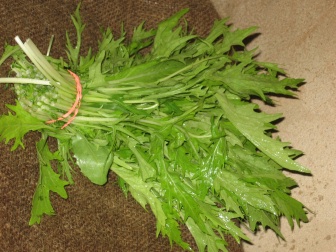 Mizuna is a feathery, light-to-medium green Japanese green with a mild mustardy flavor. Since it is in the brassica family, it shares many of the same health benefits of broccoli, brassica rabe, and cabbage.
Mizuna is a feathery, light-to-medium green Japanese green with a mild mustardy flavor. Since it is in the brassica family, it shares many of the same health benefits of broccoli, brassica rabe, and cabbage.
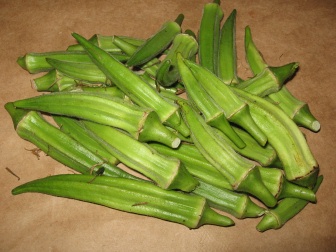 Okra (also known as gumbo), is a tall-growing, warm-season, annual vegetable from the same family as hollyhock, rose of Sharon and hibiscus. The immature pods are used for soups, canning and stews or as a fried or boiled vegetable. The hibiscus like flowers and upright plant (3 to 6 feet or more in height) have ornamental value for backyard gardens. Okra is a powerhouse of valuable nutrients. Nearly half of which is soluble fiber in the form of gums and pectins. Soluble fiber helps to lower serum cholesterol, reducing the risk of heart disease. The other half is insoluble fiber which helps to keep the intestinal tract healthy decreasing the risk of some forms of cancer, especially colorectal cancer. Nearly 10% of the recommended levels of vitamin B6 and folic acid are also present in a half cup of cooked okra.
Okra (also known as gumbo), is a tall-growing, warm-season, annual vegetable from the same family as hollyhock, rose of Sharon and hibiscus. The immature pods are used for soups, canning and stews or as a fried or boiled vegetable. The hibiscus like flowers and upright plant (3 to 6 feet or more in height) have ornamental value for backyard gardens. Okra is a powerhouse of valuable nutrients. Nearly half of which is soluble fiber in the form of gums and pectins. Soluble fiber helps to lower serum cholesterol, reducing the risk of heart disease. The other half is insoluble fiber which helps to keep the intestinal tract healthy decreasing the risk of some forms of cancer, especially colorectal cancer. Nearly 10% of the recommended levels of vitamin B6 and folic acid are also present in a half cup of cooked okra.
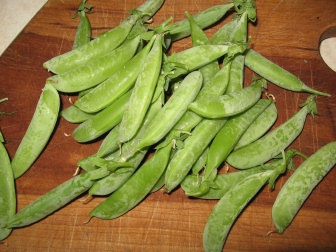 The peas that we receive at Anchor Run Farm are snow peas and snap peas. Snow peas are flatter than garden peas, and since they are not fully opaque, you can usually see the shadows of the flat peas seeds within. Snap peas, a cross between the garden and snow pea, have plump pods with a crisp, snappy texture. The pods of both snow peas and snap peas are edible, and both feature a slightly sweeter and cooler taste than the garden pea. Green peas are bursting with nutrients. They provide very good amounts of 8 vitamins and 7 minerals, including Vitamins K and B6 and folic acid in addition to dietary fiber and protein.
The peas that we receive at Anchor Run Farm are snow peas and snap peas. Snow peas are flatter than garden peas, and since they are not fully opaque, you can usually see the shadows of the flat peas seeds within. Snap peas, a cross between the garden and snow pea, have plump pods with a crisp, snappy texture. The pods of both snow peas and snap peas are edible, and both feature a slightly sweeter and cooler taste than the garden pea. Green peas are bursting with nutrients. They provide very good amounts of 8 vitamins and 7 minerals, including Vitamins K and B6 and folic acid in addition to dietary fiber and protein.
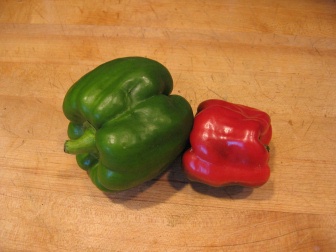 Bell peppers, also known as sweet peppers, are like the Christmas ornaments of the vegetable world since they are beautifully shaped, glossy in appearance and come in a variety of vivid colors such as green, red, yellow, orange, purple, brown and black. Despite their varied palette, all are the same plant, known scientifically as Capsicum annuum, and are members of the nighstshade family, which also includes potatoes, tomatoes and eggplant. Sweet peppers are plump, bell shaped vegetables that usually feature either three or four lobes. There are also other varieties that have a more tapered shape and no distinguishing lobes. Sweet peppers usually range in size from two to five inches in diameter and two to six inches in length. Inside the thick flesh is an inner cavity with edible bitter seeds and a white spongy core. Bell peppers have a delightful, slightly watery crunch. Green and purple peppers have a slightly bitter flavor, while the red, orange and yellows are sweeter and almost fruity. Pimento and paprika are both prepared from red bell peppers. Peppers provide a lot of health benefits and are very high in Vitamins A and C.
Bell peppers, also known as sweet peppers, are like the Christmas ornaments of the vegetable world since they are beautifully shaped, glossy in appearance and come in a variety of vivid colors such as green, red, yellow, orange, purple, brown and black. Despite their varied palette, all are the same plant, known scientifically as Capsicum annuum, and are members of the nighstshade family, which also includes potatoes, tomatoes and eggplant. Sweet peppers are plump, bell shaped vegetables that usually feature either three or four lobes. There are also other varieties that have a more tapered shape and no distinguishing lobes. Sweet peppers usually range in size from two to five inches in diameter and two to six inches in length. Inside the thick flesh is an inner cavity with edible bitter seeds and a white spongy core. Bell peppers have a delightful, slightly watery crunch. Green and purple peppers have a slightly bitter flavor, while the red, orange and yellows are sweeter and almost fruity. Pimento and paprika are both prepared from red bell peppers. Peppers provide a lot of health benefits and are very high in Vitamins A and C.
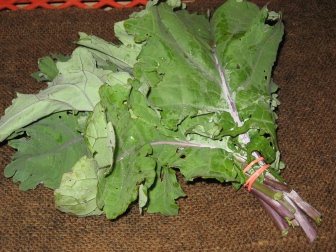 Red and white Russian kale are uncommon, old European varieties.They are quite different from either of the more common curly and Tuscan varieties: the base color is a blue-green with brighter purple accents, and the leaves are flatter than other types, with long, frilled edges. Kale is an excellent source of traditional nutrients, including vitamin A, vitamin C, vitamin B6 and manganese. It is also a very good source of dietary fiber, calcium, copper, vitamin B6, and potassium. This combination of vitamins, minerals, and phytonutrients makes kale a health superstar!
Red and white Russian kale are uncommon, old European varieties.They are quite different from either of the more common curly and Tuscan varieties: the base color is a blue-green with brighter purple accents, and the leaves are flatter than other types, with long, frilled edges. Kale is an excellent source of traditional nutrients, including vitamin A, vitamin C, vitamin B6 and manganese. It is also a very good source of dietary fiber, calcium, copper, vitamin B6, and potassium. This combination of vitamins, minerals, and phytonutrients makes kale a health superstar!
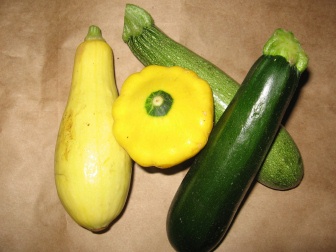 Summer squash are relatives of both the melon and the cucumber and come in many different varieties. While each type varies in shape, color, size and flavor, they all share some common characteristics. The entire vegetable, including its flesh, seeds and skin, is edible. In addition, some varieties of the squash plant produce edible flowers. Unlike winter squash, summer squash are more fragile and cannot be stored for long periods of time. Varieties of summer squash include: Zucchini: Probably the best known of the summer squashes, zucchini is a type of narrow squash that resembles a cucumber in size and shape. It has smooth, thin skin that is either green or yellow in color and can be striped or speckled. Its tender flesh is creamy white in color and features numerous seeds. Its edible flowers are often used in French and Italian cooking. Crookneck and Straightneck Squash: Both of these summer squashes have creamy white flesh and generally have yellow skins, although sometimes you can find them with green skin. Crookneck squash is partially straight with a swan-like neck. It was genetically altered to produce its straightneck cousin that is shaped as its name implies. Pattypan Squash: This small saucer-shaped squash features skin that can either be pale green or golden yellow in color. Its cream-colored flesh is more dense and slightly sweeter than that of zucchini. Nutritionally, summer squash are good contributors of Vitamins A and C, folic acid, and magnesium.
Summer squash are relatives of both the melon and the cucumber and come in many different varieties. While each type varies in shape, color, size and flavor, they all share some common characteristics. The entire vegetable, including its flesh, seeds and skin, is edible. In addition, some varieties of the squash plant produce edible flowers. Unlike winter squash, summer squash are more fragile and cannot be stored for long periods of time. Varieties of summer squash include: Zucchini: Probably the best known of the summer squashes, zucchini is a type of narrow squash that resembles a cucumber in size and shape. It has smooth, thin skin that is either green or yellow in color and can be striped or speckled. Its tender flesh is creamy white in color and features numerous seeds. Its edible flowers are often used in French and Italian cooking. Crookneck and Straightneck Squash: Both of these summer squashes have creamy white flesh and generally have yellow skins, although sometimes you can find them with green skin. Crookneck squash is partially straight with a swan-like neck. It was genetically altered to produce its straightneck cousin that is shaped as its name implies. Pattypan Squash: This small saucer-shaped squash features skin that can either be pale green or golden yellow in color. Its cream-colored flesh is more dense and slightly sweeter than that of zucchini. Nutritionally, summer squash are good contributors of Vitamins A and C, folic acid, and magnesium.
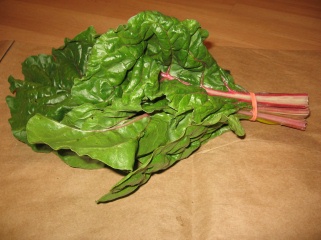 Swiss chard, along with kale, mustard greens and collard greens, is one of several leafy green vegetables often referred to as "greens". It is a tall leafy green vegetable with a thick, crunchy stalk that comes in white, red or yellow with wide fan-like green leaves. Chard belongs to the same family as beets and spinach and shares a similar taste profile. Both the leaves and stalk of chard are edible, although the stems vary in texture with the white ones being the most tender. The stems need to be cooked separately from the greens. Swiss Chard is a great source of iron, along with many other vitamins.
Swiss chard, along with kale, mustard greens and collard greens, is one of several leafy green vegetables often referred to as "greens". It is a tall leafy green vegetable with a thick, crunchy stalk that comes in white, red or yellow with wide fan-like green leaves. Chard belongs to the same family as beets and spinach and shares a similar taste profile. Both the leaves and stalk of chard are edible, although the stems vary in texture with the white ones being the most tender. The stems need to be cooked separately from the greens. Swiss Chard is a great source of iron, along with many other vitamins.
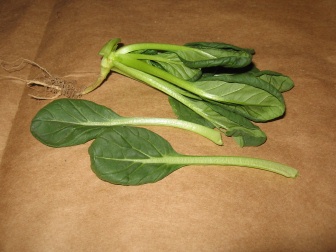 Tat soy is another form of bok choy, but has narrow white stems and rounded forest green leaves with white veins. The plant forms a loose rosette. As with others in this family, tat soy is a very good source of calcium and vitamin A and C.
Tat soy is another form of bok choy, but has narrow white stems and rounded forest green leaves with white veins. The plant forms a loose rosette. As with others in this family, tat soy is a very good source of calcium and vitamin A and C.
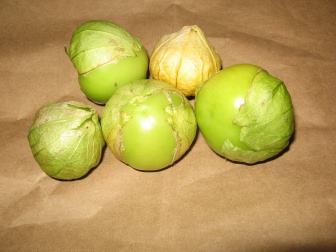 Tomatillo means little tomato in Spanish. What makes themunique in appearance is their paperlike cellulose husk covering that resembles the shape of a small green lantern that hangs downward from the bushy, annual plant on which it grows. Inside the protective husk is a smooth, plump, firm variety of tomato that is usually picked green. When fully ripened, they are actually yellow, but these are rarely brought to market. The husks turn a greenish brown when the fruit is losing its freshness. With their dense, highly seeded interior, tomatillos burst with a distinctive tart, lemony flavor that makes them the perfect ingredient in Mexican dishes such as Salsa Cruda, a fresh salsa dish, as well as Salsa Verde, a cooked green sauce used in many Mexican dishes. Tomatillos also contain a pectin-like substance that thickens the sauce or salsa upon refrigeration. The highly nutritional aspects of tomatillos may surprise you. One medium raw tomatillo contains only 11 calories, yet it packs 91 mg. of potassium. That same little fruit contains 4 mg. of vitamin C, 2.4 mg of calcium, 2.38 mg. of folic acid, and 39 IU of vitamin A. Imagine the benefits if you include several in your recipe.
Tomatillo means little tomato in Spanish. What makes themunique in appearance is their paperlike cellulose husk covering that resembles the shape of a small green lantern that hangs downward from the bushy, annual plant on which it grows. Inside the protective husk is a smooth, plump, firm variety of tomato that is usually picked green. When fully ripened, they are actually yellow, but these are rarely brought to market. The husks turn a greenish brown when the fruit is losing its freshness. With their dense, highly seeded interior, tomatillos burst with a distinctive tart, lemony flavor that makes them the perfect ingredient in Mexican dishes such as Salsa Cruda, a fresh salsa dish, as well as Salsa Verde, a cooked green sauce used in many Mexican dishes. Tomatillos also contain a pectin-like substance that thickens the sauce or salsa upon refrigeration. The highly nutritional aspects of tomatillos may surprise you. One medium raw tomatillo contains only 11 calories, yet it packs 91 mg. of potassium. That same little fruit contains 4 mg. of vitamin C, 2.4 mg of calcium, 2.38 mg. of folic acid, and 39 IU of vitamin A. Imagine the benefits if you include several in your recipe.
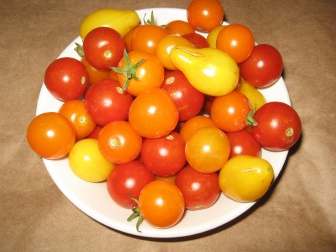 Tomatoes are probably one of the best known vegetables - botanically, they are a fruit. Many people have not had the good fortune to eat tomatoes that are picked at the peak ripeness and flavor. They come in many shapes and colors and for the most part are interchangeable.If your recipe requires seeded tomatoes, cut the fruit in half horizontally and gently squeeze out the seeds and the juice. It is especially important when cooking tomatoes to not use aluminum cookware since their high acid content will interact with the metal. This may result in the migration of the aluminum into the food, which will not only impart an unpleasant taste, but more importantly, may have deleterious effects on your health.From a health standpoint, much has been documented about the benefits of tomatoes, but in a nutshell, they provide a large amount of Vitamins C, A and K, and one of the highest amounts of lycopene of any foodsource.
Tomatoes are probably one of the best known vegetables - botanically, they are a fruit. Many people have not had the good fortune to eat tomatoes that are picked at the peak ripeness and flavor. They come in many shapes and colors and for the most part are interchangeable.If your recipe requires seeded tomatoes, cut the fruit in half horizontally and gently squeeze out the seeds and the juice. It is especially important when cooking tomatoes to not use aluminum cookware since their high acid content will interact with the metal. This may result in the migration of the aluminum into the food, which will not only impart an unpleasant taste, but more importantly, may have deleterious effects on your health.From a health standpoint, much has been documented about the benefits of tomatoes, but in a nutshell, they provide a large amount of Vitamins C, A and K, and one of the highest amounts of lycopene of any foodsource.
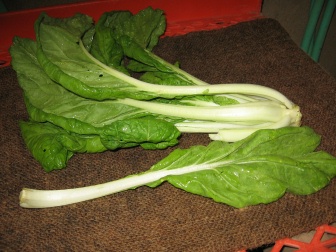 An entirely different and delicious leafy green brassica crop with bright green leaves and white stalks. The tender leaves are flavorful, but not at all mustardy. Since it is in the brassica family, it has the same great nutritional profile as broccoli and cabbage
An entirely different and delicious leafy green brassica crop with bright green leaves and white stalks. The tender leaves are flavorful, but not at all mustardy. Since it is in the brassica family, it has the same great nutritional profile as broccoli and cabbage


